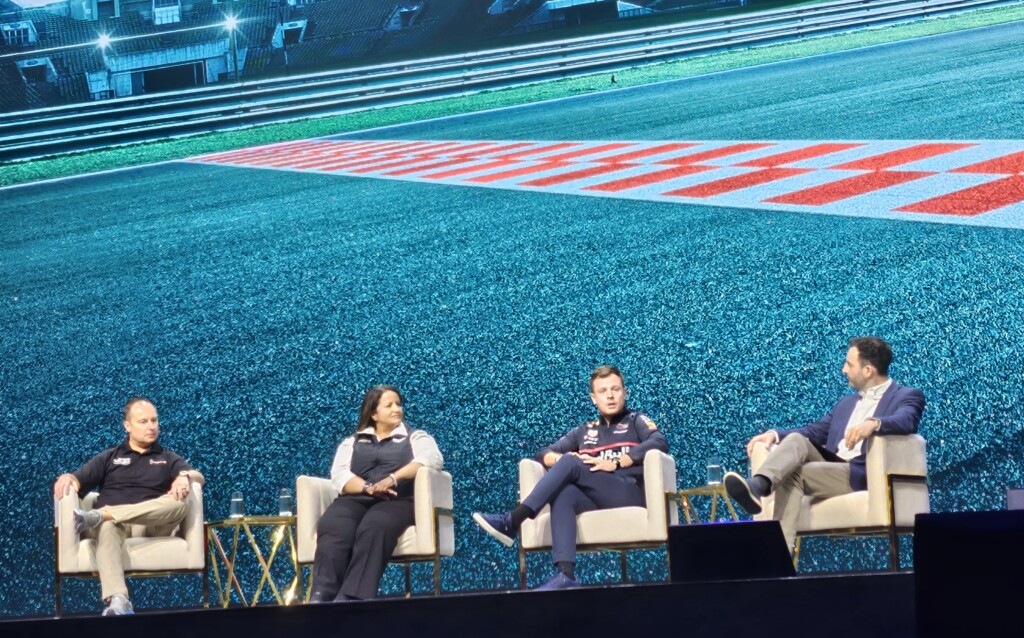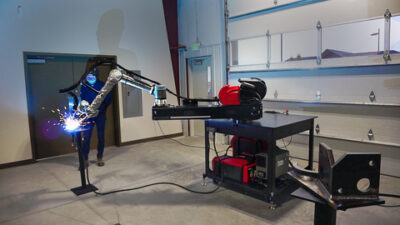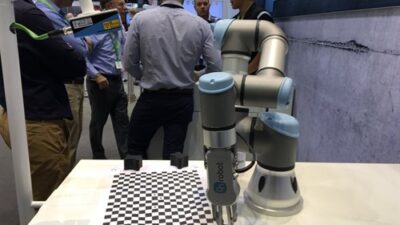Red Bull Racing, Hendrick Motorsports, and JDC-Miller MotorSports compare development cycles, challenges, and experiences with three very different kinds of racing.
Car racing has been around almost as long as cars have, and with each new advance in automotive technology, motorsports has become proportionally more sophisticated. I was reminded of that earlier this year at Hexagon Live while attending a panel discussion between four people with enviable vocations for any motorsport fan.
Morgan Maia, senior manager for technical partnerships at Oracle Red Bull Racing, Alba Colón, director of technical partnerships at Hendrick Motorsports, and John Church, president of JDC-Miller MotorSports sat down with moderator (and former professional racing driver and host of the YouTube motorsport engineering channel Driver61) Scott Mansell to share their unique perspectives on three different forms of motorsport: Formula One, NASCAR, and IMSA.
What follows is an edited and abridged version of their conversation.
Scott Mansell: You each represent very different forms of motorsport with very different challenges. Can you take a minute to explain your discipline?
Morgan Maia: Sure. In Formula One, the challenge is massive. We have 24 races a year, traveling around the world—from China and Japan to the U.S. and Europe. It’s difficult to always have the car in one piece because we have to trust that everything works straight off the truck without all the tools at hand.
Another challenge is the cost cap. We cannot spend more than $150 million per year. While that sounds like a lot, it goes quickly once you account for employees, parts, travel, and logistics. The challenge is to compete within those limits while ensuring both drivers perform at their best across 24 races.
Alba Colón: Can I have your budget? (laughs) NASCAR is a bit different. Imagine 40 cars running 38 weekends a year. Just last week, for the first time, we raced outside the U.S. in Mexico. We don’t only race on ovals, like in Las Vegas, we also compete on road courses and even dirt tracks. So our cars must be ready for any kind of surface on any kind of track, 38 weekends a year.
We’re holding at around 180 mph normally, with finishes sometimes separated by just 0.01 seconds between first and second place. Pit stops are under 9 seconds. So you can imagine how important precision is.
John Church: IMSA is endurance racing. We run a Porsche 963 hybrid in the Hypercar (GTP) class. Everything in endurance racing is about precision and consistency. We sometimes go through multiple body parts during a race weekend, so everything has to be built to exact specifications to ensure consistency across changes.
We start our season with a 24-hour race, then we do some shorter races that are only 100 minutes long, and we also do medium races that are two hours and forty minutes as well as some six-hour races. So whenever we’re changing parts out, it’s important that the whole car stays consistent from one race to the next throughout the weekend.
Scott Mansell: Let’s get into the technical meat of how your teams run at the top of their motorsport. Being successful in motorsports is all about measurement because you can’t improve if you can’t measure anything. So, how are you using Hexagon tools to improve your performance, both in the workshop and on the racetrack?
Morgan Maia: We use Hexagon in two main ways. First, at the factory. We’re always working with prototypes and don’t have time to test the car before heading to a race. A part might be manufactured on Thursday evening, shipped overnight, and fitted Friday morning for FP1. That means we must be absolutely sure that part is perfect, because we can’t send it back. It has to work immediately with the other 8,000 components on the car.
The second use is for regulations. We send a 3D CAD model of our car, then scan the real car at the track to overlay the two and ensure compliance. If the car isn’t in regulation, we can’t race.
Scott Mansell: So when you bolt the gearbox on, for example, you’re checking everything is perfectly aligned with the engine and chassis. What kind of tolerances are you working with?
Morgan Maia: We’re working with microns. The car is like a watch: everything must be extremely accurate. Even temperature matters. For example, if you start the engine cold, tolerances can be off enough to cause catastrophic failure. So everything must be warmed properly. Micron-level precision is how we find the extra tenths we need to win.
And the drivers feel everything. They can detect a millimeter or even a micron difference. Their feedback can sometimes be sharper than the data itself. Precision gives them confidence to push the car to its limits.
Scott Mansell: Alba, how are you using Hexagon products in NASCAR?
Alba Colón: Well, you’ll find Hexagon tools everywhere in our shop. NASCAR regulations changed a few years ago with the Gen-7 car. Before, we designed and built about 80% of the car ourselves. Now, to control costs, we buy around 80% and only design 20%.
That means we measure absolutely everything we receive: the chassis, the body, all the parts of the vehicle. Everything must be precise. Our Hexagon equipment ensures those parts meet tolerance before going out, since we’re not allowed to bring any of that equipment to the track, so we have to make sure everything we’re taking there is precisely measured.
Scott Mansell: And you’re not just measuring the bodywork, for example, to make sure it’s in tolerance. I’m sure there’s some engineering going on there to try and gain performance by mixing and matching different parts. What’s that like?
Alba Colón: Absolutely, yes. We do a lot of mixing and matching because, for example, this chassis makes more sense to use with that suspension. It’s like a chess game every week, putting together the perfect car.
Scott Mansell: John, what about IMSA?
John Church: In IMSA, when we unload at the track, we go straight to technical inspection. The whole car is scanned, top and bottom, and we’re allowed only a 3mm deviation from the datum.
So before leaving the shop, we scan the entire car and overlay it with the datum to make sure we’re within spec. If something’s off, we fix it before we even load the truck. That saves time and it means less drama with the officials. In endurance racing, everything’s precise until you start hitting things, and then when you need to replace the nose, you want to know each one is exactly the same. Consistency is what matters: your average pace is more important than your fastest lap.
Scott Mansell: Three millimeters sounds like a lot of tolerance when we’re talking about microns, but I’m sure your engineers are thinking, “Let’s go to 2.99999,” so they can get as close to the edge as possible.
John Church: Of course, you’re always trying to push the envelope where you can, but it’s more about making sure everything’s legal and, beyond that, making sure every replacement part that’s going on your car is the same as the last one so the drivers and the engineers have the confidence that it’s the same car as the previous session. If you can’t do that, that’s when the wheels start to fall off the bus.

Scott Mansell: Morgan, you mentioned the incredibly fast development cycles in Formula One. How quickly can you turn around a design to manufacturing and then get it on the actual car?
Morgan Maia: So, again, we always need to have the cost cap in mind, but we also do around a thousand upgrades on the car in a year, so almost all the parts are going to be changed between the first and last phase.
On top of that, setup varies a lot by circuit. If you look at Monza versus Monaco, the car can be almost completely different: same parts, but a completely different car. We push the setup on the track as well.
In Canada, for example, the car fared quite well in Q1, but we didn’t want to leave it at that, because maybe there’s an extra two tenths [of a second] to find. Then in Q2 we find we went a bit too extreme, so we refined again for FP3, still trying to beat FP1. So, there’s a lot of back-and-forth on the track to find the limits of the car and extract all the performance we can from it.
Scott Mansell: These changes you’re making to the toe or camber can make a huge difference in performance and drivability. How often are you making them?
Morgan Maia: There isn’t much time during a race weekend, so a lot happens in the simulator. Our drivers spend days (and sometimes nights) running laps to define the theoretical best setup. Then we reconcile that with driver preference and feel.
Alba Colón: We’re similar regarding simulators, except we can’t make trackside changes with measurement tools like you can. We only get 20–25 minutes of practice, so that’s maybe three changes at most.
At the track, you go through inspection once. If you fail, you get a second chance with the scanner. Fail again and you start losing team members or starting positions, and on some tracks that’s really not great.
Sometimes a driver goes out, does a few laps and then says, “It’s good, so don’t touch it!” And I think that’s because they’re worried we might make things worse if we chase those little changes. Of course, we always want more practice—we used to have two hours!—but now it’s 20 minutes and those are the rules of the game, so we have to do our best to take advantage of what we have in front of us.
Scott Mansell: You mentioned that you’re not allowed to take measurement equipment to the circuit, so what does the process look like when it comes back from the factory? Is it checked then or when it has a new setup for the next race?
Alba Colón: So before the car goes on the track, it goes through a scanner for a 90-second scan that’s mandated by NASCAR. Based on the color map and the tolerances, you’re cleared to race. Then, when the vehicle comes back, we scan it again to see what moved based on what we did at the track.
Within a couple of hours, the whole car is pulled apart and we take photos of measurements of everything to decide which parts will stay and which will be scrapped. By that time, the car that’s going out for the next weekend is already finished and we’re already assembling another vehicle two or three weeks in advance, so there’s constant measurement to make sure everything is working.
Scott Mansell: With such quick turnarounds, the speed of engineering must be critical.
Alba Colón: Very critical. When I left the shop last week, we were already working on the car for a race a month from now, and it’s pretty much ready. So we’re moving parts really, really quickly. If you want a job in racing, and you’re in quality control or manufacturing, trust me: we’re looking for you.
Scott Mansell: John, when your cars come back to the factory, what does that process look like for you?
John Church: Very similar to what Alba was saying. When the car comes back, the first thing we do is scan it just to see how much everything has changed from the start of the weekend. Of course, damage is always obvious, but even where there isn’t any damage, just seeing if anything moved and taking note of it to make adjustments is crucial for going forward.
I think what we’re all trying to do here is control as many variables as we can so that we can guarantee repeatability from one car to the next, one race to the next. That makes everybody’s job a lot easier because it takes the guesswork out of it.



